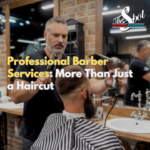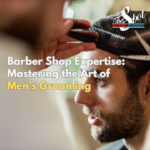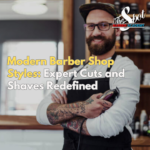Barbershop vs. Salon Differences
When you think of getting a haircut, two primary venues might come to mind: the traditional barbershop and the modern salon. Both places offer unique experiences, and the choice between them often boils down to personal preference, the desired style, and the atmosphere you’re seeking. In this blog post, we’ll delve deep into the key differences between Barbershop vs. Salon Differences to help you make an informed decision the next time you decide to change up your look.
History and Tradition
Barbershops have been around for centuries, serving as communal gathering spots for men. In ancient times, barbers were not only responsible for grooming but also for performing surgical procedures, hence the term “barber-surgeons.” The iconic red, white, and blue barber pole is a nod to this history, symbolizing the bandages and blood from the surgeries. Over time, barbershops evolved into places primarily for grooming, where men could get a shave and a haircut while discussing politics, sports, and daily life.
Salons, on the other hand, have a more recent history, emerging in the 20th century as places primarily for women. Salons became spaces for beauty treatments, including hair coloring, manicures, and facials, in addition to haircuts. They emphasized luxury, relaxation, and pampering, often with elegant décor and a wider range of services.
Services Offered
One of the primary differences between barbershops and salons is the range and type of services they provide.
Barbershops typically focus on shorter, traditionally male hairstyles and offer services like beard trimming, shaving, and sometimes even facial massages. They specialize in classic cuts, fades, and buzz cuts.
Salons, conversely, cater to a broader audience, including both men and women. They provide a wider range of services, from hair coloring and treatments to perms, extensions, and intricate styling. Salons often employ specialists for each service, ensuring expertise in every domain.
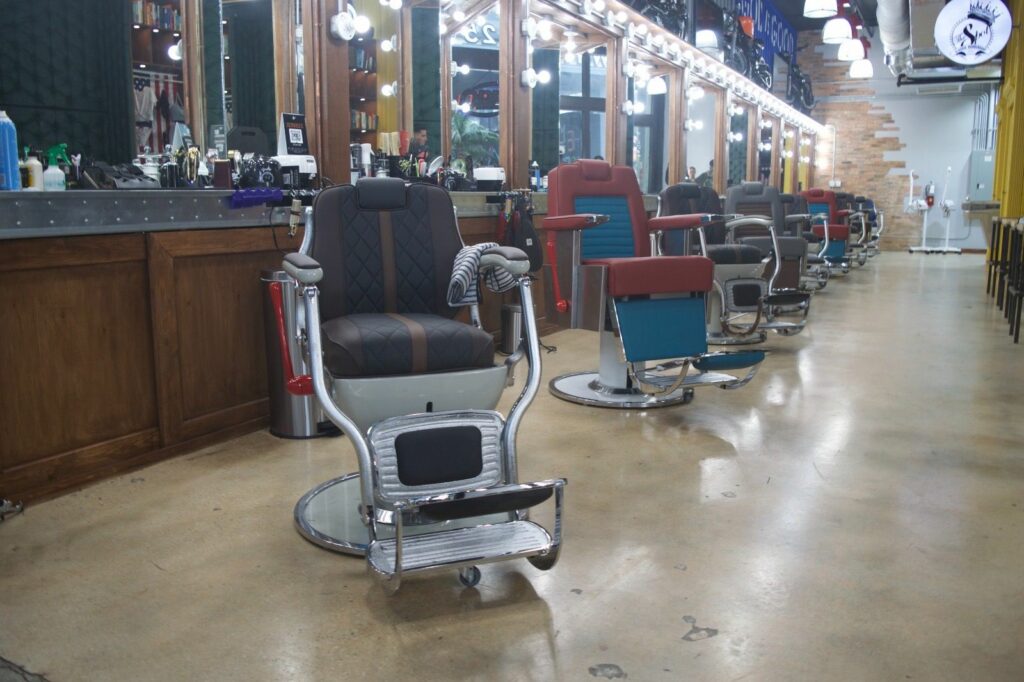
Training and Expertise
Both barbers and hairstylists undergo rigorous training, but their areas of expertise differ.
Barbers are trained to work primarily with shorter hair and specialize in techniques such as layering, fading, and tapering. They also learn the art of wet shaving and beard grooming. Their tools of choice often include clippers, straight razors, and shears.
Hairstylists in salons, meanwhile, receive training in a broader range of hair types and lengths. They become experts in coloring, highlighting, and various hair treatments. Their toolkit often consists of brushes, blow dryers, curling irons, and various hair products.
Atmosphere and Vibe
The ambiance of barbershops and salons can vary greatly.
Barbershops often exude a more casual, laid-back atmosphere. They might have sports playing on a TV, leather chairs, and a more “masculine” décor. Conversations in barbershops can range from the latest football game to local news, creating a community feel.
Salons, on the other hand, often have a more upscale, serene environment. Soft music, plush chairs, and a focus on relaxation are common. The conversations in salons might revolve around fashion, beauty trends, or personal stories.
Salon: From Powder Rooms to Beauty Empires
The term “salon” originally referred to gatherings in France where intellectuals would discuss literature, art, and politics. Over time, it came to represent places of beauty and grooming.
In the 18th century, powdered wigs and elaborate hairstyles were all the rage in European courts. This led to the emergence of specialized salons catering to the aristocracy.
The 20th century brought about significant changes. With the advent of cinema, Hollywood became a significant influencer in beauty standards. Salons started offering a wider range of services, from perms to hair coloring, catering to these new trends.
Cultural Impact and Societal Significance
Barbershops and salons have always been more than just places to get a haircut. They play a pivotal role in society, influencing and being influenced by cultural shifts.
Barbershops have often been seen as safe spaces for men to discuss personal and societal issues. They’ve played roles in political movements, especially in African-American communities, serving as places for community organizing and discussion.
Salons, on the other hand, have been instrumental in championing women’s rights. They’ve provided women with opportunities for entrepreneurship and financial independence. Furthermore, they’ve been places for women to connect, share stories, and offer support.
Modern-day Trends and Innovations
Today, the lines between barbershops and salons are blurring. Many establishments now cater to both men and women, offering a comprehensive range of services.
Eco-friendly salons are on the rise, focusing on sustainable practices, using organic products, and reducing their carbon footprint.
Barbershops are embracing modern aesthetics, with many adopting a retro-chic look, harking back to the golden age of barbering but with a contemporary twist.
Technology is playing a crucial role in transforming the grooming industry. From online booking systems to virtual hair consultations, the digital revolution is reshaping the way we think about grooming.
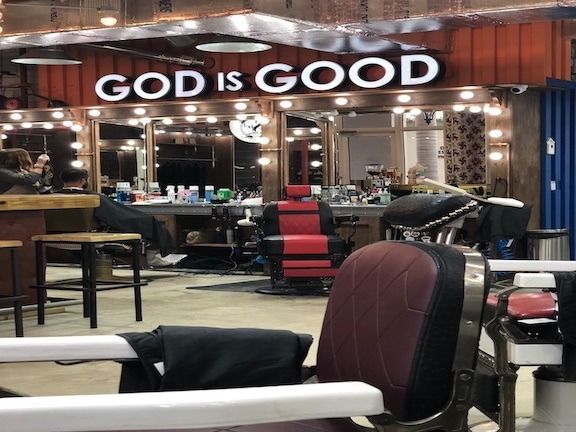
Pricing and Appointments
While this can vary depending on the location and reputation of the establishment, barbershops generally have a more straightforward pricing model, with set prices for specific services. Appointments might not always be necessary, especially in traditional barbershops.
Salons often have a tiered pricing system based on the experience level of the stylist or the complexity of the service. Appointments are usually required, especially for more intricate services or treatments.
The Evolution of Barbershops and Salons
As we look back at history, both barbershops and salons have undergone significant transformations. Their evolution provides valuable insights into societal changes, cultural shifts, and emerging trends.
Barbershops Through the Ages
The ancient barbershop traces its roots back to Egypt, where barbers held esteemed positions in society. Hieroglyphs from ancient Egyptian tombs depict barbers at work, showcasing the significance of grooming even in those times.
In medieval Europe, barbers often doubled as surgeons, performing minor surgical procedures. They were known as “barber-surgeons” and were essential members of the community. As medical science advanced, the roles of barbers and surgeons began to diverge, leading to the establishment of distinct professions.
The 19th and 20th centuries witnessed the golden age of barbershops in America. These establishments became social hubs, with patrons spending hours engaged in lively discussions. The decor was simple, with wooden floors, large mirrors, and iconic barber chairs.
The Intersection of Fashion and Grooming
Fashion and grooming have always walked hand-in-hand. Both are forms of self-expression, with the potential to boost one’s confidence, create a sense of identity, and even make socio-political statements.
Fashion Through the Lens of Hairstyling
Throughout history, hairstyles have been symbols of status, rebellion, and conformity. In the Roaring Twenties, the bob cut became emblematic of women’s liberation. This short hairstyle, popularized by flappers, was a defiant move against the traditional long locks that were seen as a standard of femininity.
In the 1960s and 70s, the Afro became a potent symbol of Black pride and the civil rights movement. Meanwhile, in other parts of the world, long hair on men was seen as a form of rebellion against conservative norms.
Today, hairstyles continue to evolve, reflecting socio-cultural shifts, technological advancements, and global influences. From the androgynous looks of the 80s to the vibrant hair colors of today’s Gen Z, hair remains a powerful medium of self-expression.
Grooming Products: A Historical Perspective
The use of grooming products is not a modern phenomenon. Ancient Egyptians used kohl for eye makeup and henna for coloring hair and nails. Romans were known for their elaborate bathing rituals, incorporating a range of oils and scrubs.
The Victorian era saw the rise of beauty salons and a plethora of grooming products, many of which have evolved into modern cosmetics. The 20th century marked a boom in the beauty industry, with brands exploring innovative formulations, packaging, and marketing strategies.
Today, the grooming industry is a multi-billion dollar sector, with products catering to diverse needs and preferences, from organic skincare lines to high-tech beauty gadgets.
The Role of Celebrities and Influencers
Celebrities have always played a pivotal role in setting grooming and fashion trends. From Audrey Hepburn’s pixie cut to David Beckham’s ever-evolving hairstyles, stars have been the benchmark for style for decades.
However, the rise of social media has democratized the world of fashion and grooming. Today, influencers, with their relatable content and engaged followers, have as much sway, if not more, than traditional celebrities. Platforms like Instagram and TikTok are reshaping beauty standards, promoting inclusivity, and highlighting niche trends.
Barbershop and Salon Etiquettes
While the primary goal of visiting a barbershop or salon is grooming, there are unspoken etiquettes that patrons are expected to follow. Respecting appointment times, providing clear communication about desired services, and tipping appropriately are all part of the grooming experience.
On the flip side, professionals in these establishments are trained to provide not just technical services but also a holistic experience. Building rapport, understanding client preferences, and ensuring a comfortable environment are integral to the ethos of grooming professionals.
The Psychology of Grooming
At a fundamental level, grooming is about hygiene and appearance. But delve a little deeper, and it becomes evident that it’s also about mental well-being. A good haircut can boost one’s confidence, while a spa session can be therapeutic.
Salons and barbershops often become spaces of vulnerability, where patrons open up about their lives, fears, and aspirations. For many, a visit to these establishments is as much about emotional rejuvenation as it is about physical grooming.
Sustainability in the World of Grooming
With growing awareness about environmental issues, sustainability is becoming a significant focus in the grooming industry. Salons and barbershops are exploring eco-friendly practices, from reducing water wastage to using biodegradable products.
Brands are investing in research to develop sustainable packaging, reduce their carbon footprint, and ensure ethical sourcing of ingredients. The rise of vegan and cruelty-free products is a testament to the industry’s commitment to sustainability.
The Fusion of Technology and Grooming
The digital age has ushered in a plethora of innovations, and the grooming industry is no exception. Cutting-edge technology is revolutionizing how we approach haircare and skincare, creating a seamless blend of science and art.
Smart Hair Tools: Gone are the days when hair tools were limited to simple mechanical devices. Today’s hair straighteners and curlers come equipped with sensors that adjust the temperature based on hair type, ensuring minimal damage. Hairdryers with ionic technology reduce frizz by neutralizing positive ions, resulting in smoother locks.
Augmented Reality (AR) in Salons: AR apps allow customers to virtually try on different hairstyles and colors before making a decision. This not only enhances the customer experience but also reduces the likelihood of dissatisfaction post-service.
Personalized Skincare: With the advent of AI, it’s now possible to get skincare recommendations tailored to individual needs. By analyzing photos of one’s skin, algorithms can suggest products that address specific concerns like acne, pigmentation, or wrinkles.
Eco-tech Products: Sustainability isn’t just about ingredients. Brands are now launching eco-tech products, like solar-powered hairdryers or water-saving showerheads, catering to the eco-conscious consumer.
Conclusion
Whether you prefer the nostalgic charm of a barbershop or the luxurious experience of a salon, understanding their key differences can help you choose the right place for your grooming needs. Remember that it’s not just about the haircut or style; it’s also about the experience, the conversation, and the atmosphere.
And if you’ve ever felt a calling towards the world of barbering, consider turning your passion into a profession. Join our Barbering program at The Spot Barber Academy. Learn from the best, hone your skills, and embark on a rewarding career in this timeless craft.


